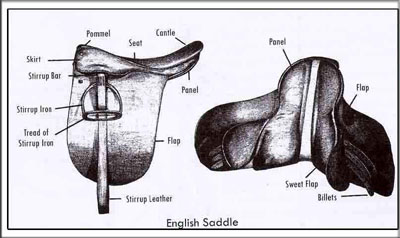
| Horse Hippology | ||

|
||
Depending on the Western discipline and the conformation of the horse, different rigging may be used to help the saddle fit the horse and purpose better. Although no single type of rigging is restricted to only one purpose, in general there are common riggings for particular uses. Full double rigging is used for roping; seven-eighths and three-fourths double rigging are used for reining, cutting and pleasure; in-skirt rigging is used for pleasure and trail, and center fire rigging is used on pack saddles and bucking saddles.

|
If the saddle does not clear the withers but instead rests on them, then either the fork or saddle is too wide, or the withers of the horse are too high and narrow, or perhaps both contribute to the problem. In any case, the ill-fitting saddle may cause injury to the withers and will be painful, leading to bucking, head throwing and/or "cinchiness."
Width of the withers should be measured two inches below the top of the withers, to correspond to the fork width of the saddle. Both Western and English tree widths are measured across the bottom of the gullet.
The seat of the Western saddle is measured from the base of the horn to the front center edge of the cantle. The seat of the English saddle is measured from the head nail to the center of the cantle.
In general, a Western blanket or pad extends further beyond the edges of the saddle than does a blanket or pad for an English saddle. Both should, however, be larger than the saddle, which rests upon them. Good horsemanship also requires that they be kept relatively clean.
Western saddles need a pad or saddle blanket between the saddle and the horse's back. These are made of a variety of materials: wool, cotton, sheepskin or synthetic fibers. Most synthetic materials can be washed and are easy to clean. The "hair pad" has been popular because of durability, and when soiled with dirt and sweat, the dirt can be brushed out. Wool blankets are expensive and need to be dry cleaned, but should last for many years if well cared for.
Saddle pads are not not necessary for English saddles, but may be used for training and pleasure riding. The pad is held in place under the saddle by passing the billets through two straps on the pads. English pads are usually made of sponge rubber, synthetic fiber, sheepskin or felt.